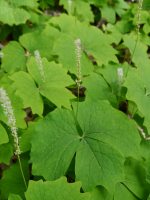A lso called sweet after death and deer foot, vanilla leaf is a herbaceous perennial native to western North America from British Columbia south to California where it forms a dense ground cover in moist shady forests. It is a member of the barberry family, Berberaceae, that also includes Oregon grape (Mahonia) and barrenworts (Epimedium and Vancouveria). Plants grow up to 14″ tall from a rhizomatous root system and have mid- to light green leaves 2-3″ wide. The leaves are palmately compound with 3 leaflets that may be toothed or lobbed. In spring small white flowers are produced in a narrow fluffy spike up to 2.75″ long. The flowers lack petals and sepals but have 8-20 long white stamens. The genus name, Achlys, honors the Greek goddess, daugher of Nyx (night), who personified misery and sadness. The specific epithet, triphylla, comes from the Latin/Greek prefix tri-, meaning 3, and Greek suffix -phyllus, meaning leafed and refers to the 3 leaflets of each compound leaf. The common name deer foot refers to the configuration of the leaves while the common names, vanilla leaf, and sweet after death, refer to the sweet vanilla scent of the dried crushed leaves.
lso called sweet after death and deer foot, vanilla leaf is a herbaceous perennial native to western North America from British Columbia south to California where it forms a dense ground cover in moist shady forests. It is a member of the barberry family, Berberaceae, that also includes Oregon grape (Mahonia) and barrenworts (Epimedium and Vancouveria). Plants grow up to 14″ tall from a rhizomatous root system and have mid- to light green leaves 2-3″ wide. The leaves are palmately compound with 3 leaflets that may be toothed or lobbed. In spring small white flowers are produced in a narrow fluffy spike up to 2.75″ long. The flowers lack petals and sepals but have 8-20 long white stamens. The genus name, Achlys, honors the Greek goddess, daugher of Nyx (night), who personified misery and sadness. The specific epithet, triphylla, comes from the Latin/Greek prefix tri-, meaning 3, and Greek suffix -phyllus, meaning leafed and refers to the 3 leaflets of each compound leaf. The common name deer foot refers to the configuration of the leaves while the common names, vanilla leaf, and sweet after death, refer to the sweet vanilla scent of the dried crushed leaves.
Type: Herbaceous perennial
Bloom: Spikes of small fluffy flowers with long white stamens but no petals or sepals; in spring
Size: 12-14″ H x 5′ W
Light:Part shade, shade
Soil: Fertile, medium moist, well-drained
Hardiness: Zones 7-9
Care: Low maintenance
Pests and Diseases: None of significance
Propagation: Seed, root division
Companion Plants: Ferns, hosta, thimbleberry, western bleeding heart, trillium